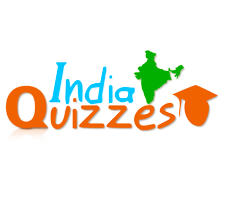- Dispersion
- Total Internal Reflection
- Refraction
At the time of Qutubuddin Aibak’s death, Iltutmish was the Subedar ofWhich country has launched the world’s first Braille Atlas for visually impaired persons? Carnotite is a mineral of which among the following metals? Consider the following statements:
1. In the First Round Table conference, Dr. Ambedkar demanded separate electorates for the depressed classes.
2. In the Poona Act, special provisions for representation of the depressed people in the local bodies and civil services were made.
3. The Indian National Congress did not take part in the Third Round Table Conference.
Which of the statements given above is/are correct? Who among the following is known as ‘Martin Luther’ of India? What is the India’s GDP forecast for FY18 by IMF in its latest World Economic Outlook (WEO) report? GK quiz set 995 – general knowledge for SSC, UPSC, IAS and other competitive exams for effective prepration for SSC, HSSC, PSC, IAS, UPSC and other exams. GK online MCQ test with questions from different general awarness topics.
- Annie Besant
- Bhikaji Cama
- M.G. Ranade
- Madan Mohan Malviya
Which among the following is NOT a search engine?
- Baidu
- Wolfram Alfa
- Yahoo
- Lebanon
- Jordan
- Israel
- Palestine
Explanation:
Dead Sea is a salt lake bordered by Jordan to the east and Israel and Palestine to the west. It is also lowest point of Asia, 395 meters down sea level.
Consider the following:
- Dispersion
- Total Internal Reflection
- Refraction
- 1
- 1,2
- 1,2,3
- 2,3
- Delhi
- Gwalior
- Badayun
- Lahore
- China
- India
- Japan
- France
Explanation:
The world’s first Braille Atlas for visually impaired persons has been launched by Dr. Harsh Vardhan, the Union Minister for Science and Technology and Earth Sciences. The special edition of the “Atlas for Visually Impaired (India)” in English Braille has been prepared by National Atlas and Thematic Mapping Organisation (NATMO) under the Department of S and T. The Atlas priced at Rs.600 and has 20 maps that cover themes such as physical, socio-economic and cultural aspects such as river system, natural vegetation, Metropolitan cities, roads, food and cash crops. The Atlas will be distributed free of cost to various schools across India for educating the students with visual challenges.
Carnotite is a mineral of which among the following metals?
- Lead
- Uranium
- Aluminium
- Iron
1. In the First Round Table conference, Dr. Ambedkar demanded separate electorates for the depressed classes.
2. In the Poona Act, special provisions for representation of the depressed people in the local bodies and civil services were made.
3. The Indian National Congress did not take part in the Third Round Table Conference.
Which of the statements given above is/are correct?
- 1 and 2
- 2 and 3
- 1 and 3
- 1, 2 and 3
- Swami Vivekanand
- Swami Shraddhanand
- Raja Ram Mohan Roy
- Swami Dayanand Saraswati
What is the India’s GDP forecast for FY18 by IMF in its latest World Economic Outlook (WEO) report?
- 7.0%
- 6.7%
- 7.1%
- 6.5%
Explanation:
The International Monetary Fund (IMF) has recently released its October 2017 World Economic Outlook. In it, IMF slashed India’s growth forecast by 0.5% points to 6.7% in FY 18 due to the lingering effects of disruption caused by demonetisation and transition costs of GST. Earlier, in April, the IMF had pegged India’s GDP growth at 7.2% for FY18. It has also lowered the growth projection for FY 19 ( 2018-19) to 7.4% from its earlier estimate in April and June of 7.7%. Though, the IMF was more optimistic about medium-term growth prospects for India through gains from the new indirect tax levy. Apart from IMF, the Reserve Bank of India (RBI) has also lowered its growth projection to 6.7% for the current financial year from its earlier estimate of 7.3% due to adverse impact on economic growth by the implementation of Goods and Services Tax (GST).



